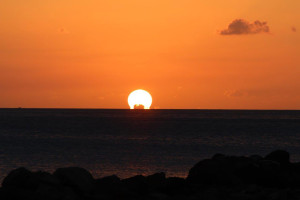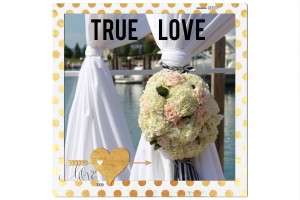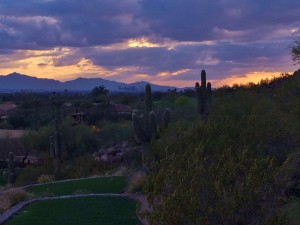I’m not sure when it was that I first heard about the phenomenon of the green flash. I don’t remember when I first looked for it. I just know that I’ve been looking for years.
Throughout my lifetime of chasing sunsets, I never spotted a bright green glow rise above the setting sun. Dozens, maybe hundreds, of times I planted myself on a shoreline at dusk. My feet sifted the sand between my toes. I faced the horizon and watched the sun drop below the surface of the earth in the exact spot where the ocean met the sky. There, I admired a dramatic display of light as the sun and sky swirled clouds and blended colors together before resting for the night. Never did I see the end of a day punctuated with an exclamatory pop of green.
It was as if the celestial wonder was determined to hide from me. I began to doubt its very existence. I surmised that, even if it was real, catching a glimpse of the green flash at sunset was as unlikely an experience as viewing Halley’s Comet.
In 2007, Disney writers spun Caribbean lore to their advantage when they presented an explanation for the elusive sighting in Pirates of the Caribbean: At World’s End. Onboard a pirate ship and navigating a crew to Davy Jones’ Locker—the Underworld—Captain Barbossa asked deckhand, Gibbs, “[Have you] ever gazed upon the green flash?”
Gibbs began a dramatic response: “I reckon I’ve seen my fair share. Happens on rare occasion; the last glimpse of sunset, a green flash shoots up into the sky. Some go their whole lives without ever seeing it. Some claim to have seen it who ain’t. And some say—”
“It signals when a soul comes back to this world, from the dead!” crewman Pintel interrupted Gibbs and finished the statement.
Impressive storytelling, I thought upon hearing those lines, but I recognized the clever manipulation amongst them. Writers and producers had already created a fictitious world in which cursed men were unable to die and at least one mangy pirate looked strangely attractive. Why not suspend belief further by breathing life into something else that wasn’t real? I was now convinced that the green flash was just a myth.
In March of 2015, I met a Caribbean woman who perpetuated the legend. Relatives and I spent one of our vacation days in Nevis. We waited for a ferry to take us back to St. Kitts where we had rented a condo for a week. The gatekeeper at the dock in early evening was the same person who braided tourists’ hair on the beach during the heat of the day. We didn’t recognize her, but rather she—quite observant and well acquainted with the comings and goings of visitors—noticed us.
Her name was Sweet Pea, and she created goodwill by meeting and greeting island guests. Among her favorites, I found out, were Kelly Ripa and her daughter, Lola. Sweet Pea had braided Lola’s hair, of course.
While my family and I talked with Sweet Pea, the night sky started to poke the sun downward. Our host became excited and told us to watch the horizon for the green flash. I had to look away from her for a moment in order to hide my smirk. I also couldn’t let her see me rolling my eyes in disbelief of this touristy tale.
The sun continued to lose its commanding presence in the night sky. As if embarrassed by its decreasing status, the sun found a place to hide. It slipped behind a ship that had been docked and abandoned sometime long-ago in the tiny port. For sure now, we wouldn’t be seeing the green flash—or fabricating an impressive story of having seen it.
Sweet Pea didn’t give up. She urged my husband to hurry and make his way to the stationary ship for a better look. “Climb to the highest spot you can! Quickly! You don’t want to miss it!” She was insistent, so off my husband, Greg, ran with his camera in hand. I turned to my in-laws and dismissed the nonsense. “It’s just a myth,” I said. Sure enough, Greg came back without having seen a green flash in the distant horizon.
That night, we returned to our condo and researched this supposed phenomenon. Some of us just couldn’t let it go. That’s when I learned that I was wrong. Physicists, airplane pilots, NASA scientists, and layman all have something credible to say about green flashes. My family and I were intrigued to hunt again.
Two nights later, we packed our cameras and a telescopic lens and drove to a nearby beach. For awhile, it hurt to look at the setting sun, which meant we shouldn’t be doing that just yet. The sun needed to sink further down before it couldn’t damage our eyesight, but no one wanted to miss seeing the green flash. We continued stealing peeks.
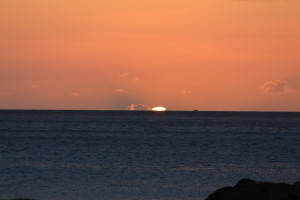
A green tinge is beginning to form along the outer edges of the oblong-shaped sun as it sets below the horizon.
With precision, each of us gazed as the sun settled. A cruise ship passed by. A cloud rolled in. A small boat skirted off to the south. While all those others seemed disinterested, we were riveted and hopeful. The sun sunk lower and lower. It touched the surface of the water and continued sinking.
The perfectly round shape became more and more oblong, but tinier and tinier. In the next instance, the oblong image completely separated from and hovered over the ocean.
We were rewarded for our renewed faith. We saw a green bubble, an oval of light, a dot in the exclamation point that marked “The End!” of our search.
.
.
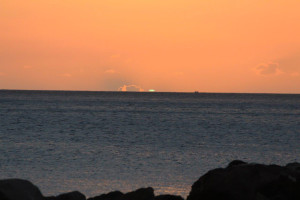
The marvelous green flash appears off the coast of St. Kitts, March 20, 2015. Photograph, Greg Bixby
The green flash appeared and disappeared almost immediately—less than a second or two, as we expected from our research. Greg’s timing was just right. He captured the moment in pictures!
My disbelief had turned to awe in two short days. It seemed as if true belief was a prerequisite to finding it.
I never expected to see it again.
Just seven months later, I had fun telling a golf partner about it while we finished a round at Torrey Pines in San Diego. I shared my story as the sun was quickly setting. My new friend had never heard of the green flash, so I told her to carefully watch the sun itself in its final performance of the day. Our husbands moved ahead of us, while we two ladies paused to look out over the ocean. This time there were no cameras to capture the sighting, but our hooting and hollering announced our thrill of seeing it.
I don’t know if I’ll ever be lucky enough to see the green flash for a third time, but I’ll forever be chasing sunsets in search of it. If I’m really blessed, I may even spot the epic blue flash.
Learn more about the green flash at astronomer Andrew T. Young’s page: www-rohan.sdsu.edu/~aty.

